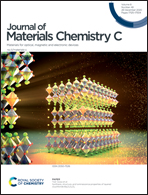Efficient deep-blue organic light-emitting diodes employing difluoroboron-enabled thermally activated delayed fluorescence emitters†
Abstract
The design and development of efficient emitters for deep-blue OLEDs with CIEy < 0.10 remains a challenge. A new series of tetracoordinated difluoroboron (BF2)-enabled thermally activated delayed fluorescent (TADF) materials with D–A-BF2-type and D–π–A-BF2-type frameworks for sky-blue to deep-blue emitters were designed and developed. The emission colors could be effectively tuned through regulating the degree of conjugation between the highest occupied molecular orbital (HOMO) and lowest unoccupied molecular orbital (LUMO) by simply introducing a methyl group into the phenyl ring to adjust the molecular geometries and change the acceptor moieties, which were strongly supported by the density functional theory (DFT) calculations and electrochemical studies. All the tetracoordinated difluoroboron TADF emitters are air-stable and insensitive to moisture, and they are strongly emissive in degassed toluene peaking at 435–471 nm with high photoluminescence quantum efficiencies (PLQYs) of 94–99%. The BF2-MPCz-doped sky-blue OLED demonstrated a peak EQE of 13.8% with a Lmax value of 20853 cd m−2 and CIE coordinates of (0.175, 0.354), and the BF2-DMCz-doped deep-blue OLED achieved a peak EQE of 8.4% with CIE coordinates of (0.149, 0.083). This indicates that the BF2-enabled TADF materials can act as efficient emitters for the fabrication of sky-blue to deep-blue OLEDs.



 Please wait while we load your content...
Please wait while we load your content...